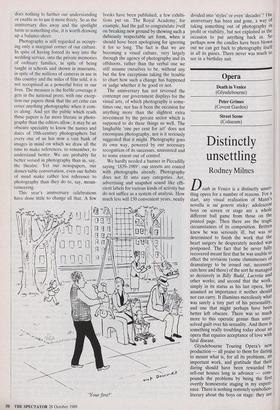Photography
Still a Cinderella
Francis Hodgson reflects on photography's 150th anniversary Eighteen thirty-nine is an entirely arbitrary date for the birth of photography. In that year the French government granted a pension to Louis Jacques Mande Daguerre in order that his process might pass into the public domain, and William Henry Fox Talbot published his Some Account of the Art of Photogenic Drawing, or, The Process by Which Natural Objects May be Made to Delineate Themselves without the Aid of the Artist's Pencil. But in that pamphlet Fox Talbot himself dated his first successes to 1834, and Daguerre had signed a contract with Nicephore Niepce in 1829 which contained as a supplement Niepce's Notice sur l'heliographie which is itself a long, detailed and accurate account of a photographic process. In 1802 the physicist Thomas Wedgwood and the chemist Sir Humphry Davy had published (in the Journal of the Royal Institution) An Account of a Method of Copying Paintings upon Glass, and of Making Profiles, by the Agency of Light upon Nitrate of Silver, which is a complete photographic process without the discovery of any fixing agent to make the images permanent.
All of these are well known plausible early landmarks in the history of photogra- phy. A few prehistorians have gone even further back: Rosalind Krauss in Tracing Nadar, for example, or Peter Galassi in Before Photography. Josef Maria Eder's monumental Geschichte der Photographie (of which the first part was published in 1881) starts with Aristotle, which is perhaps stretching it a little.
None of this should matter. Public rela- tions persons seem to like anniversaries, and any convenient date serves their pur- poses. In the generation of the 'heritage business' anniversaries spell money, or attention in the media at the very least. But it is highly questionable how much lasting benefit is derived from the Disneyfication of culture which results from such packag- ing. Photography means more than a few star names and a handful of large indus- tries. It actually affects the way we have come to think. Not as respectably ancient as prose, it offers similar possibilities of infinitely varied expression; granting it an anniversary every so often draws attention to it, even perhaps from those who have never given it a moment's thought, but does nothing to further our understanding or enable us to use it more freely. So as the anniversary dies away and the spotlight turns to something else, it is worth drawing up a balance-sheet.
Photography is still regarded as occupy- ing only a marginal corner of our culture. In spite of having forced its way into the wedding service, into the private memories of ordinary families, in spite of being taught in schools and shown in museums, in spite of the millions of cameras in use in this country and the miles of film sold, it is not recognised as a powerful force in our lives. The measure is the feeble coverage it gets in the national press; with one excep- tion our papers think that the art critic can cover anything photographic when it com- es along. And yet the public which reads those papers is far more literate in photo- graphy than the editors allow; it may be an obscure speciality to know the names and dates of 19th-century photographers but every one of us has now a vast bank of images in mind on which we draw all the time to make references, to remember, to understand better. We are probably far better versed in photography than in, say, the theatre. Yet our newspapers, our dinner-table conversation, even our habits of mind make rather less reference to photography than they do to, say, moun- taineering.
This year's anniversary celebrations have done little to change all that. A few books have been published, a few exhibi- tions put on. The Royal Academy; for example, had the gall to congratulate itself on breaking new ground by showing such a dubiously respectable art form, when it should have been apologising for ignoring it for so long. The fact is that we are becoming a visual culture, very largely through the agency of photography and its offshoots, rather than the verbal one we still assume ourselves to be, without any but the few exceptions taking the trouble to chart how such a change has happened or judge whether it be good or not.
The anniversary has not reversed the contempt our government displays for the visual arts, of which photography is some- times one, nor has it been the occasion for anything more than the slightest extra investment by the private sector which is supposed to do these things so well. The laughable 'one per cent for art' does not encompass photography, nor is it seriously suggested that it might. Photography goes its own way, powered by our necessary recognition of its successes, unassisted and to some extent out of control.
We hardly needed a banner in Piccadilly saying `1839-1989': our streets are coated with photographs already. Photography does not fit into easy categories. Art, advertising and snapshot sound like effi- cient labels for various kinds of activity but do not suffice as a system of analysis. How much less will 150 convenient years, neatly `Your first?' divided into 'styles' or even 'decades"! 'the anniversary has been and gone, a way of taking something out of photography in profit or visibility, but not exploited as the occasion to put anything back in. So perhaps now the candles have been blown out we can get back to photography itself in all its guises. There never was much to see in a birthday suit.



































































 Previous page
Previous page